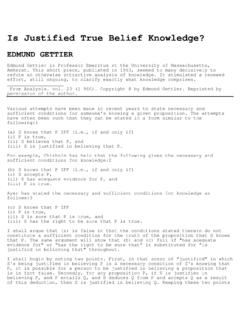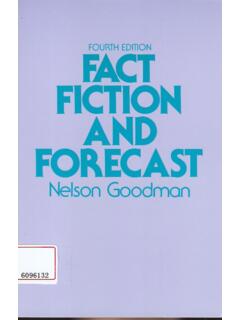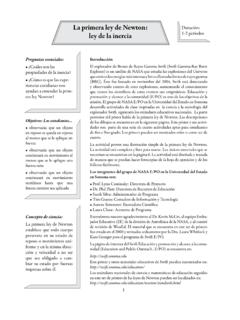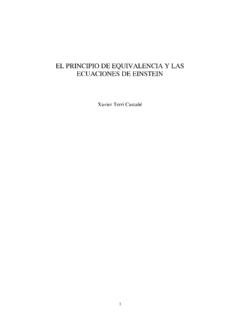Transcription of Carl Hempel, Two Models of Scientific Explanation
1 3 CarlHempel, "TwoModelsofScientificExplanation"CarlGu stavHempel's(1 9 0 5- 1 9 9 7)clas sicaccountof explanationiswidelyknown asthe"cover ing-law model . "It includ estwospecies :theDeductive-NomologicalExplanationandt heProbabilistic-StatisticalExpla-nation. Sinceitsintroductioninthesemi nalpaper co-authoredby Hempeland Paul Oppenh eim(1 9 4 8),themodelhas beenintense lydebatedandcriticizedin thephilosophyof scien ce literat althoug hcertainexperimentsare always necessary to serve as abasisforreasoning, nevertheless, oncetheseexperimentsare given,we shou ld derivefrom themeverythingwhichanyoneat allcouldpossibly derive; andweshou ldeven discoverwhatexperimentsremaintobe donefor theclarificationof all further dou bts.
2 Thatwouldbe an admira ble help, even inpoliticalscienceand medicine,to stea dyandperfect reasoningconcerninggiven symp-tomsandcircumstances. For even whiletherewill not be eno ughgivencircum-sta ncestoform an infalliblejudgment, we sha llalways be abletodetermin ewhatis most proba bleon the dat a is all thatreason can do.(TheGeneralScience,Leibniz, 1677) factorsthath a veencouragedandsustainedscienti ficinqui rythrough itslo n gh istory are tw o pervasivehuman concernsw hichprovide, It hi n k,the b a sicmotiva t ionforall Scientific research . Oneoftheseisman'spers iste n tdesire toimproveh is strategicpositionintheworl d bym eans of dep en dablemethodsforpredictinga n d,whenever possible,con-tr oll in gtheeventsthatoccurinit.
3 Theexte n t to whic hscienceh a sbeen ableto satis fythis urgeis reflectedimpressivelyinthe vast andsteadi : "Explanat ion inScienceand Hist ory," inFrontiersofScienceandPhilosoph y ,ed. Colodny,1962, : The University ofPitt besides thispracticalconcern,thereis asecondbasicmotivationfor the scientificquest,namely,man'sinsatiablein tellectualcuriosity,his deepconcerntoknowtheworldhe livesin,andtoexplain,andthustounderstand ,theunendingflow ofphenomenait presentsto timespastquestionsas to thewhatandthewhyoftheempiricalworldwereo ftenansweredbymyths;andto someextent,this is so even inourtime.
4 Butgradually,themythsaredisplacedbytheco ncepts,hypotheses,andtheoriesdevelopedin thevariousbranchesofempiricalscience,inc lud-ing thenaturalsciences,psychology,andsociolo gicalas well thegeneralcharacterof theunderstandingattainablebythesemeans,a ndwhatis itspotentialscope? In thispaperI willtrytoshedsomelightonthesequestionsby examiningwhatseem to me thetwobasictypesofexplanationofferedby thenaturalsciences, ,then,a lookatexplanationin Types of Deductive-NomologicalExplanationIn hisbook,HowWeThink,lJohnDeweydescribesan observationhemadeone daywhen,washingdishes,hetooksomeglasstum blersoutofthehotsoapsudsandputthemupside downona plate:henoticedthatsoapbub-blesemergedfr omunderthetumblers'rims,grewfor awhile,cameto astandstill,andfinallyrecededinside thishappen?
5 TheexplanationDeweyoutlinescomesto this: Intransferringa tumblerto theplate,coolair iscaughtin it; this air isgraduallywarmedby the glass,whichinitiallyhas thetemperatureof thehotsuds. Thewarmingof the air isaccompaniedby anincreasein itspressure,whichinturnproducesanexpansi onof thesoapfilmbetweentheplateandthe ,theglass cools off,andso does the airinside, anargumentto the effectthattheeventto beexplained(let me call it theexplanandum-event)was tobeexpectedbyreasonofcertainexplanatory facts. Thesemaybedividedintotwogroups:(i)partic ularfactsand(ii)uniformitiesexpressedby these: thetumblershadbeenimmersed,for some time, insoapsuds of atemperatureconsiderablyhigherthanthatof thesurroundingair.
6 Theywereput,upsidedown,ona plateonwhicha puddleofsoapywaterhadformed,providinga connectingsoap46"TWOMODELSOFSCIENTIFICEX PLANATION"film, itemspresupposedin theargumentincludesthe gas lawsandvariousotherlawsthathavenotbeenex plicitlysuggestedconcerningtheexchangeof heatbetweenbodiesofdifferenttemperature, theelasticbehaviorofsoapbubbles, ,the ideasuggestsitselfofconstruingtheexplana tionas adeductiveargumentof thisform:(D)Cj,C2, ,C,Lj,L2, ,LrEHere,Cj,C2, ,C,arestatementsdescribingtheparticularf actsinvoked;Lj,L2, ,L, aregenerallaws:jointly,thesestatementswi ll be said is astatementdescribingtheexplanandum-event ; let me call ittheexplanandum-statement,andlet me usetheword"explanandum"torefertoeitherEo rto theeventdescribedby will calldeductive-nomologicalexplanation;for itamountsto adeductivesubsumptionof theexplanandumunderprincipleswhichhaveth echaracterofgenerallaws: itanswersthequestion"Whydid theexplanandumeventoccur?
7 "byshowingthattheeventresultedfromthepar ticularcircumstancesspecified in Cj,C2, ,Ckinaccordancewiththe laws Lj,L2, , ,asexhibitedinschema(D), hasthereforebeenreferredtoas thecoveringlawmodel,oras thedeductivemodel, ,forexample,theexplanationofmirror-image s,ofrainbows,orof theappearancethataspoonhandleis bentat thepointwhereitemergesfroma glassofwater:in allthesecases, theexplanandumisdeductivelysubsumedunder the laws ,certainaspectsof free fallandofplanetarymotioncanbeaccountedfo r bydeductivesubsumptionunderGalileo'sorKe pler' theillustrationsgiven so far theexplanatorylawshad,byandlarge, thecharacterofempiricalgeneralizationsco nnectingdifferentobservableaspectsof thephenomenaunderscrutiny:angleofinciden cewithangleofreflectionorrefraction,dist ancecoveredwithfallingtime,etc.
8 But scienceraisesthequestion"why?"alsowithre spectto theuniformitiesexpressedbysuchlaws,andof tenanswersit inbasicallythesamemanner,namely,bysubsum ingtheuniformitiesundermoreinclusivelaws , ,thequestion,"WhydoGalileo'sandKepler'sl awshold?"is answeredbyshowingthattheselaws arebutspecialconsequencesof theNewtonianlaws ofmotionandofgravitation;and47 CARLHEMPEL these,inturn, anincreaseinbreadth,orscope,becausethene wexplanatoryprinciplescoverabroaderrange ofphenomena;forexample,Newton'sprinciple sgovernfree fall ontheearthandonothercelestialbodies,as well asthemotionsofplanets,comets,andartifici alsatellites,themovementsofpendulums,tid alchanges, isstrikinglyreflectedinthefactthat,inthe lightofmoreadvancedexplanatoryprinciples ,theoriginalempiricallawsareusuallyseen toholdonlyapproximately, ,Newton'stheoryimpliesthatthefactorg inGalileo'slaw, s=1;2gr',isnotstrictlyaconstantfor free fallnearthesurfaceoftheearth.
9 Andthat,since everyplanetunder-goesgravitationalattrac tionnotonlyfromthesun,butalsofromtheothe rplanets,theplanetaryorbitsarenotstrictl yellipses,asstatedinKepler' par-ticulareventis oftenconceivedasspecifyingitscause, ,theaccountoutlinedinourfirstillustratio nmightbeheldtoexplainthegrowthandtherece ssionofthesoapbubblesbyshowingthatthephe nomenonwascausedby a riseanda subsequentdropofthetemperatureoftheairtr appedinthe ,however,thesetemperaturechangesprovidet herequisiteexplanationonlyinconjunctionw ithcertainotherconditions,suchastheprese nceof asoapfilm,practicallyconstantpressureoft heair sur-roundingtheglasses, ,inthecontextofexplanation,a causemustbeallowedtoconsistin amoreor lesscomplexset ofparticularcir-cumstances;thesemightbed escribedby a set ofsentences:Cj,Cz.
10 , Ck And,assuggestedbytheprinciple"Samecause, sameeffect,"theassertionthatthosecircums tancesjointlycauseda givenevent-described,let us say,by asentenceE-impliesthatwheneverandwhereve rcircumstancesofthekindinquestionoccur, aneventofthekindto ,thegivencausalexplanationimplicitlyclai msthattherearegenerallaws-suchas Lj,Lz,.., L" inschema(D)-byvirtueofwhichtheoccur-renc eofthecausalantecedentsmentionedin Cj,Cz,.., Ckis asufficientconditionfortheoccurrenceofth eeventto ,therelationbetweencausalfactorsandeffec t isreflectedinschema(D):causalexplan-atio nisdeductive-nomologicalincharacter.(How ever,thecustomaryfor-mulationsofcausalan dotherexplanationsoftendonotexplicitlysp ecify alltherelevantlawsandparticularfacts: to thispoint,we willreturnlater.)







